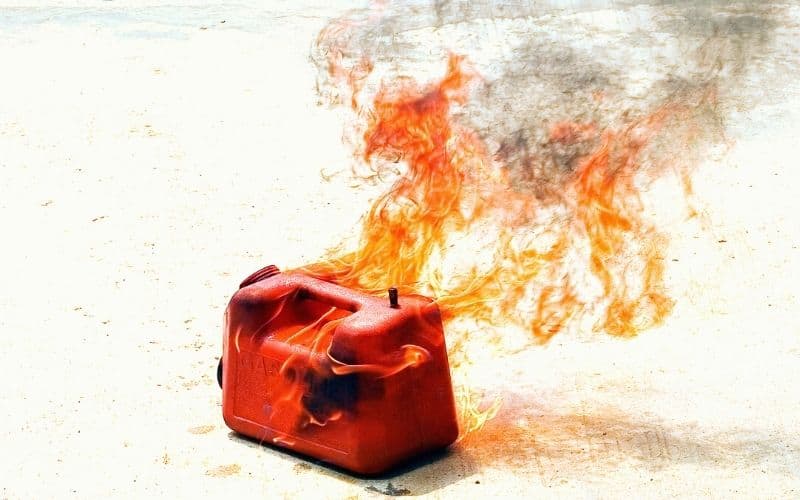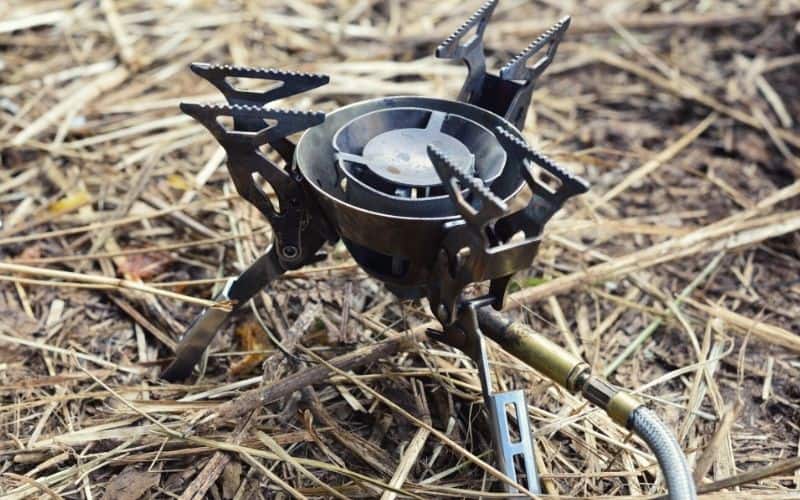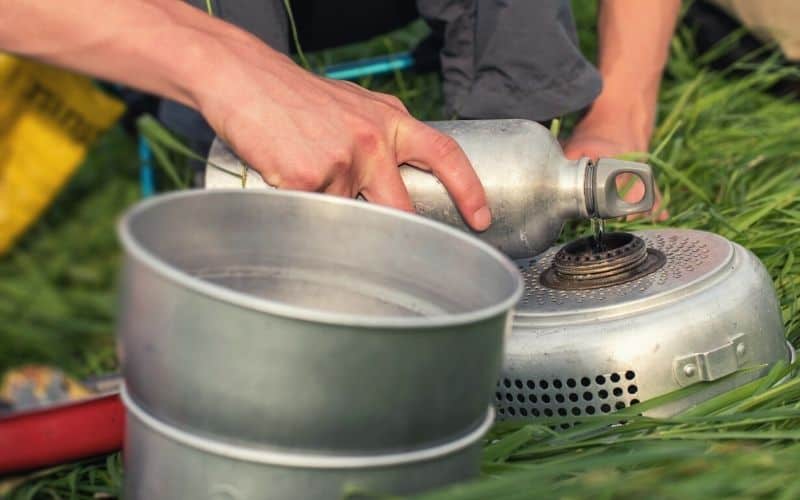When it comes to camping fuel, the whole plethora of choices out there can become overwhelming. If you’ve been surveying these options and trying to get to grips with all the science and confusing lingo involved, the chances are you’ve come across the fuel that goes by the name of white gas.
In this post, we’ll provide insight into why this fuel is a great option for camping and backpacking, and how it compares to the alternatives.
Table of Contents
A Brief Bio of White Gas
White gas is a liquid petroleum fuel often known as “Coleman fuel,” but can also be found under other names like “naphtha”, “100% light hydro-treated distillate,” or LPG.
This gas is in liquid form at room temperature and comes from petroleum. It’s completely clear and usually sold in one-gallon tins. As it’s a distillate gaseous fuel, Coleman fuel contains no additives, unlike gasoline. It was originally produced for cars but is now sure to be found in any ardent backpacker’s gear for use as lantern fuel or camping stoves.

It’s used by various brands, including Primus, MSR, Kovea Spider, and Optimus.
Benefits
White gas is notable for its purity compared to other camping fuels. This means it burns cleanly and you can worry less about annoying burn marks on your pots and pans. You’ll also have less of a nasty odor if you spill, as you’re likely to if you’re anything like the author of this post.
You’ll also get the perk of less gumming up of the fuel line. Not only will you avoid the annoying and unpleasant task of cleaning out your camping stove, but you’ll also be more assured that it won’t flare or burn.
White gas has an incredibly high energy emission as compared to propane or kerosene. To get really sciencey about it, it boasts a carbon content of 5 to 9 carbon atoms per molecule. So if you’re boiling one gallon of water, you’ll use much less of it than propane for the same results.
This type of camp fuel burns hot and fast, which saves time for card playing or story-telling around the fire rather than waiting for pasta water to boil. This is also a boon for you savvy winter campers out there, as it will quickly melt snow.

White gas also excels when it comes to convenience. You can control the temperature of the stove to avoid burning your food, or when you want to amp up the temp for a quicker cook.
As you get used to it, it’s easy to estimate how much white gas you need to cook with. For example, in the summer you’ll likely want four ounces per person per day and in the winter you’ll want eight ounces per person per day.
It’s easy to tell how much white gas you have left in a container, which isn’t the case with a non-liquid fuel like propane. You just look into the fuel bottle rather than guessing by weight.
It’s also simple to refill fuel bottles, and discarding a white gas bottle is equally easy as they’re recyclable.
You also don’t need to be concerned with extremely low temperatures if you’re cooking with white gas because it has a low freezing point and flashpoint, which is the lowest temperature at which fluids can turn from liquid form into gases. What this means is that the liquid will vaporize more quickly regardless of how low the temperature drops. In short, it’s a winner for winter camping.

If you’re more of a dabbler in the world of outdoor cooking or camping, there’s no need to worry about white gas going bad on the shelf. An unopened bottle has a shelf life of up to seven years. Once it’s cracked, however, you’ll want to use it within the year.
You can buy white gas in most camping stores or even gas stations, especially in North America. In addition to being relatively inexpensive, you’ll also use less white gas in the long run as it will burn fast and hot. It can also be used in multi-fuel stoves (stoves that can use LPG, unleaded fuel, butane, and propane).
And the Drawbacks?
White gas is not without its faults in comparison to other camping fuels. Regular campers know that it can be a bit finicky to work with as it involves pumping and priming.
You’ll need to pump stoves to ensure the fuel has enough pressure to rise to the burner. Gas stoves will already be pressurized in this way.
Priming white gas is also key. This involves pre-heating fuel that is at room temperature to make sure it vaporizes when you need to cook your food.
Always make sure it is stored away from flames because it’s a highly flammable fuel. And because it’s a liquid, you’re more prone to spilling it than a pressurized fuel like propane, which you can knock over without any issues.

You may also want to check for leakages from your fuel canister. You might not notice them as you would any other fuel due to its odorless nature.
Why Is White Gas Such a Good Fuel Type for Camping and Backpacking?
White gas is ideal for camping and backpacking. You can use it year-round as it works well at any temperature and its storage containers are lighter than something like propane or butane.
It is also slightly more environmentally friendly than other fuels since you don’t have to think about how to dispose of the containers.
Is White Gas More Dangerous Than Other Liquid Fuels?
White gas does indeed require a few more safety precautions when you’re using it around camp. However, it is not necessarily any more dangerous than other fuels if you take the right precautions.
Before you light your stove, check the various parts like the fuel line, valves, burner head, and other connections. If there’s leakage in these areas you could risk an accidental explosion.

It’s best to use stoves on level ground. You’ll avoid yet more spillages. Likewise, be sure the clamp to the fuel line is tightly secured to avoid spillages.
Avoid using your stoves inside your tent or an otherwise poorly ventilated area. White gas can give off fumes that could give you carbon monoxide poisoning. This is a good rule of thumb for any fuels you might be using to cook with.
You’ll want to avoid filling the canister all the way up as you need to leave a bit of room for the pressurized air that you pump. White gas will expand as it warms, so you want to make sure it has the space to do so.
Try to avoid using white gas that has been open for more than a year. Like any petroleum product, there could be impurities in the fuel that may lead to a clog and subsequent burning through of your stove.
Use extra caution when pouring this fuel into its container as a spillage on your bare skin in low temperatures could lead to frostbite.
White Gas Vs. Kerosene (Paraffin)
White gas is superior to kerosene in almost every way. Kerosene is dirtier and produces more soot. White gas has higher heat output but burns hotter, so you’ll have a shorter cook time. Both need to be pumped before use to generate pressure.
Both types of fuel are cheap and easy to find in retailers.
White Gas Vs. Propane
Propane is marginally a better performer in winter. It’s also slightly more fuel-efficient than white gas and easier to use since you don’t have to concern yourself with the finicky priming and pressurizing process.

White gas, however, will burn hotter and more quickly than propane, especially in freezing temperatures. And if two camp stoves burn the same amount of WG or propane fuel, the white gas stove will burn hotter.
White Gas Vs. Butane
Butane cooking fuel is the hardest to find in retailers. It’s also the poorest performer of the bunch in cold temperatures.
Butane, however, has a far longer shelf life than WG – a boon for those of us that don’t get outdoors as much as we’d like.
White Gas Vs. Alcohol
If you’re looking for efficiency, choose Coleman fuel over alcohol.
It can be a bit tricky to find fuel for alcohol stoves as there are so many kinds of alcohol. It’s also not ideal for camping or backpacking in cold conditions due to its higher flashpoint.

What is White Gas? Final Thoughts
When it comes to cooking time and performance in varying conditions, white gas can’t be beaten for camping and backpacking. As mentioned above, however, it’s best to think about your specific needs and usage requirements before choosing which type of cooking fuel is best for you!
Now we’ve answered the question “what is white gas?” Are there any more burning questions you still have? Or do you have any more ideas about which cooking fuel is best for what? Comment below for your own recommendations!

